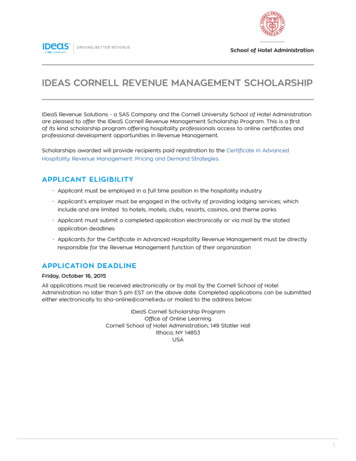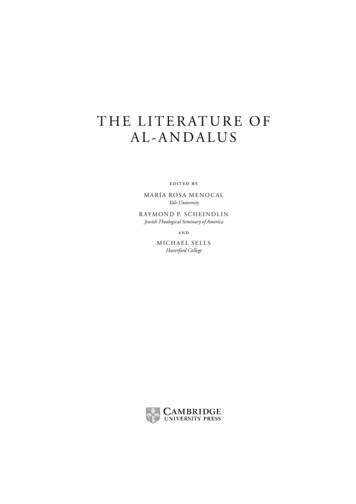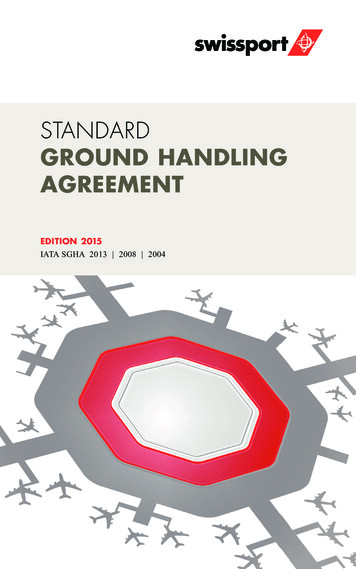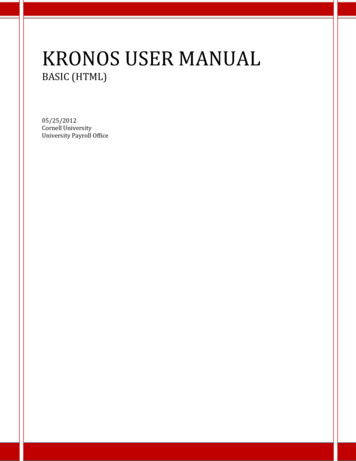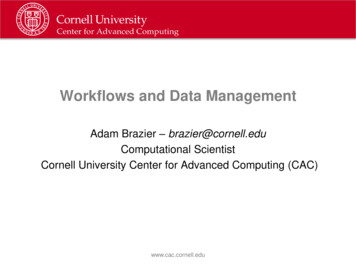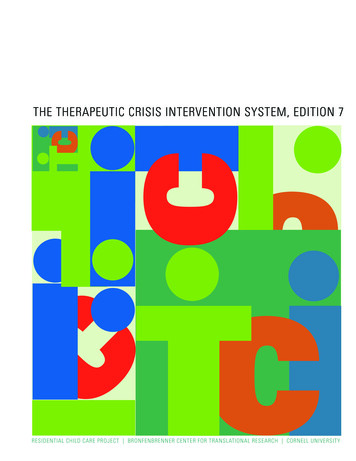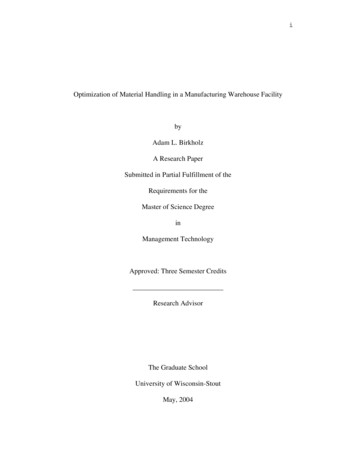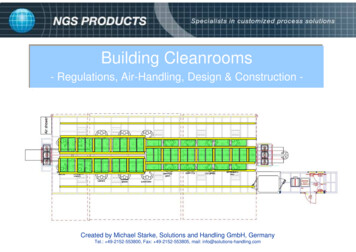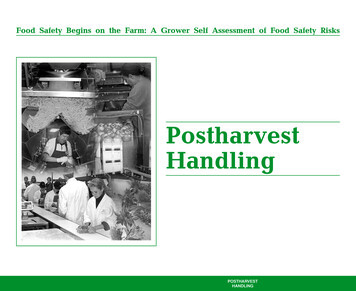
Transcription
Food Safety Begins on the Farm: A Grower Self Assessment of Food Safety RisksPostharvestHandlingPOSTHARVESTHANDLING
POSTHARVESTHANDLINGPostharvest Handling and Packing FacilitiesOnce produce has been harvested, care must be takento prevent either direct orcross contamination of the cropduring grading, washing,packing and shipping. Severalfoodborne illness outbreaks infruits and vegetables havebeen traced back to packingoperations. ImplementingGAPs and Good Manufacturing Practices (GMPs) duringpost harvest handling and packing can reduce microbial risks tofruits and vegetables. Adopting post harvest GAPs and GMPs arealso good for produce quality since most practices that reducegrowth of human microbial pathogens will also reduce post harvestdecay.Cool produce quickly after it has been harvested. Target pulptemperatures should optimize produce quality and ideally willminimize microbial growth. Maintaining this “cold chain” fromharvest to storage to shipping to retail display is essential to reducemicrobial (and plant) pathogen growth.Water used for washing, cooling, or icing produce must bepotable. Wash water and dump tanks can spread pathogens throughcross contamination. Disinfection of this water can reduce theserisks. Avoid cooling water bath temperatures that are more than10 F cooler than the produce pulp temperature, so that water is notdrawn into produce. This concern is highest for tomatoes, peppers,apples, potatoes, mangoes and cantaloupes.The produce handling facilities, packing areas and trucks usedfor shipping must be kept clean through scheduled washing andsanitizing programs. Produce waste should be properly disposed ofand runoff from produce fields should be prevented from enteringpacking areas. Birds, rodents, insects, and other pests should beexcluded from the packing areas.One of the most important practices to reduce post harvestmicrobial contamination of produce is worker education and training. Trained workers are important and valuable because they canidentify factors that increase fruit damage during packing such asrough handling and sharp edges on packing lines. Damaged or cutfruit can harbor pathogens and decay organisms. Effective trainingthat encourages good communication and worker participation is avaluable postharvest tool.Finally, keep records so that each package leaving the farm canbe traced to the field of origin and the date on which it was packed.Traceback information is essential for both third party auditing forfood safety as well as for inspectors in the event of a foodborneillness outbreak.Trained workers are important and valuable becausethey can identify factors that increase fruit damageduring packing such as sharp edges on packing lines.
Packing House Sanitation and SafetyGood Agricultural PracticesManagementAreaRodent, bird, and insectexclusion from packingareas Practices Requiring AttentionBestPracticeMinor AdjustmentsNeededConcerns Exist;Examine PracticeNeeds Improvement:Prioritize Changes HereAll storage and packingareas are inspected daily forrodents, birds and insects.Pest control procedures(traps, screening and doors)are used to exclude orremove pests. SOPs are inplace for pest control andservice reports areavailable.All storage and packingareas are inspected weeklyfor rodents, birds andinsects. Pest controlprocedures (traps, screeningand doors) are used toexclude or remove pests.Rodent, bird and insectactivity is apparent andinadequate controls arebeing applied. Monitoring issporadicRodent, bird and insectactivity is apparent in thepacking area but no controlshave been applied.Soil removal from produceand bins in the field, toprevent contaminatingwash water or other loadsof produceSoil is removed fromproduce and bins while inthe field. Bins are cleanedand sanitized prior toreturning to field.Bins are commonly movedinto the packing areawithout inspecting for dirt.Screening or covering ofoverhead light bulbsAll lighting fixtures in thepacking area are screenedto contain glass if light bulbsshould break.Any light fixtures are notscreened or covered in thepacking area.Backflow devices andwater sourceBackflow devices areinstalled separating dumpand flume tanks from thewater source at each pointof use.Backflow devices are notinstalled.Grower Self Assessment of Food Safety RisksPacking House Sanitation and Safety—1
Packing House Sanitation and SafetyGood Agricultural PracticesManagementAreaPacking line sanitation Packing line inspection Use of food grade oils andlubricantsPractices Requiring AttentionBestPracticeMinor AdjustmentsNeededConcerns Exist;Examine PracticeAll packing lines are washedwith soap and water, andsanitized at the end of eachday. Brushes and spongesare inspected and cleaneddaily. SOPs are in place andrecords are kept.Packing lines are washedwith soap and water on aregular schedule. Problemareas may be spot sprayedwith sanitizers. Records arekept.Crop and soil residue isremoved and packing areasare cleaned but not washedon a regular schedule.Packing lines are notcleaned except at thebeginning of the season.Packing lines are inspectedbefore each operation, toassure there are no sharpedges or drops in elevationthat may bruise produce,especially since pathogensurvival is higher in bruisedflesh. Records are kept.Packing lines are inspectedweekly for sharp edges ordrops and records are kept.Packing lines are inspectedor checked only once at thebeginning of the harvestseason.Packing lines are notinspected for drops or sharpedges that may cut or bruiseproduce.Only food grade approvedand labeled oils or lubricantsare used in the packingfacility.Grower Self Assessment of Food Safety RisksNeeds Improvement:Prioritize Changes HereFood grade oils andlubricants are not alwaysused in the packing area.Packing House Sanitation and Safety—2
Packing House Sanitation and SafetyGood Agricultural PracticesManagementAreaBestPracticeMinor AdjustmentsNeededPractices Requiring AttentionConcerns Exist;Examine PracticeNeeds Improvement:Prioritize Changes HereStorage of containersused for packing andshipping produceContainers used for packingand shipping produce arestored in an area that iscovered, and preferablyisolated from the packingarea, to insure that bins arenot exposed to rodents,dust, or condensation.Boxes for packing produceare stored in the packingarea, off the ground andpreferably, under plasticcover.Cull pile managementCull piles from harvest orpacking operations are notlocated near packing houseareas AND are removedand either composted orfield spread weekly.Cull piles from harvest orpacking operations are notlocated near packing houseareas AND are removedand either composted orfield spread every twoweeks.Cull piles from harvest orpacking operations arelocated near packing houseareas, AND are removedonce per year.Cull piles are located nearpacking house areas ANDare never removed.The pile decomposes in thesame place year after year.Handwashing practices ofworkersAll workers practice properhandwashing and wash theirhands before work, beforeand after meals, eating, andtoilet use.All workers practice properhandwashing, but do notalways wash their hands atthe critical times.Very few workers wash theirhands properly or at thecritical times.Handwashing is notmonitored or a priority.Quality of gloves whenused on the packing lineWorkers wash hands andchange to new disposablegloves, particularly aftermeals, smoking or usingtoilet facilities.Workers wash hands andwear nondisposable glovesthat are washed andsanitized daily.Grower Self Assessment of Food Safety RisksBoxes are stored in theopen, on the floor, exposedto dust and animals oroutside.Workers wearnondisposable gloves thatare not washed andsanitized daily.Packing House Sanitation and Safety—3
Packing House Sanitation and SafetyGood Agricultural PracticesManagementAreaPractices Requiring AttentionBestPracticeMinor AdjustmentsNeededConcerns Exist;Examine PracticeWorker clothingWhen smocks or aprons areused by workers who handleproduce, these garmentsare cleaned or changeddaily and are not wornoutside the packing area.Smocks or aprons are usedby workers, and they arecleaned or changed weekly.Some smocks or aprons areused but there is no policyin place about use.Shipping truck sanitationPrior to loading produce ona truck or other conveyance,the vehicle is inspected forproper temperature,cleanliness, odors, anddebris, and cleaned andsanitized, if needed.Records are kept.Prior to loading produce ona truck or other conveyance,the vehicle is inspected forcleanliness, odors, anddebris, and rinsed, ifneeded. Records are kept.The trucks are usuallyinspected and appear clean,however no washing orsanitizing is done. Norecords are kept.The trucks are not inspectedfor cleanliness; produce isjust loaded on the truck. Norecords are kept.SOPs are in place forpacking shed sanitationAND record keepingincludes routine verificationof practices.There are SOPs and recordkeeping in place, butverification is donesporadically.There are SOPs in place,but no records are kept toverify actions.There are no SOPs orrecord keeping for reducingfood safety risks. Standard operatingprocedures (SOPs) andrecord keeping to assureattention to food safetyrisk managementNeeds Improvement:Prioritize Changes Here Grower Self Assessment of Food Safety RisksPacking House Sanitation and Safety—4
Packing House Sanitation and Safety Action PlanPrioritizeChanges PracticeDate: Reviewer: Field or Commodity:Your Plans to Reduce RisksAction DateRodent, bird, and insectexclusion from packing areasSoil removal from produce andbins in the field, to preventcontaminating wash water orother loads of produceScreening or covering ofoverhead light bulbsBackflow devices and watersourcePacking line sanitationDo not remove. Photocopy this master for evaluations.Packing House Sanitation and Safety Action Plan—1 of 3
Packing House Sanitation and Safety Action PlanPrioritizeChanges PracticeDate: Reviewer: Field or Commodity:Your Plans to Reduce RisksAction DatePacking line inspectionUse of food grade oils andlubricantsStorage of containers used forpacking and shipping produceCull pile managementHandwashing practices ofworkersDo not remove. Photocopy this master for evaluations.Packing House Sanitation and Safety Action Plan—2 of 3
Packing House Sanitation and Safety Action PlanPrioritizeChanges PracticeDate: Reviewer: Field or Commodity:Your Plans to Reduce RisksAction DateQuality of gloves used on thepacking lineWorker clothingShipping truck sanitationStandard operating procedures(SOPs) and record keeping toassure attention to food safetyrisk managementDo not remove. Photocopy this master for evaluations.Packing House Sanitation and Safety Action Plan—3 of 3
Postharvest Handling of ProduceGood Agricultural PracticesManagementAreaBestPracticeSoil removal from produceand bins in the field, toprevent contaminatingwash water or other loadsof produceSoil is removed fromproduce and bins while inthe field. Bins are cleanedand sanitized prior toreturning to field.Water quality for washingproduce and making iceWater for washing produceand making ice is potablefrom a municipal or groundwater source. Results ofannual water tests are onfile. Water quality managementin dump tanks, flumes,hydrocoolers, or otherbatch water tanks Wash water is changedseveral times a day, andchlorine or other disinfectantis added and levelsmonitored continuously, tomaintain appropriate levels(crop dependent). Water pHis monitored and adjusted tobetween 6.5 and 7.5.Grower Self Assessment of Food Safety RisksMinor AdjustmentsNeededPractices Requiring AttentionConcerns Exist;Examine PracticeNeeds Improvement:Prioritize Changes HereBins are commonly movedinto the packing areawithout inspecting for dirt.Water quality for washingproduce or making ice hasnot been tested, but thesource is also the farmdrinking water.Water quality for washingproduce or making ice isfrom a ground water sourcethat has not been tested.Water for washing produceor making ice is not potableOR is from a surface watersource.Water is changed twice perday. Disinfectant is addedand pH is adjusted.Disinfectant levels and pHare monitored every 1 to 2hours.Disinfectants are not used indump tank, flume water, orhydrocoolers. Water ischanged sporadically basedupon a visual assessment ofclarity or cleanliness.Postharvest Handling of Produce—1
Postharvest Handling of ProduceGood Agricultural PracticesManagementAreaBestPracticeMinor AdjustmentsNeededTemperature managementof water in dump tanksWater temperature in dumptanks and flumes is regularlymonitored to be no morethan 10 F cooler thanproduce. SOPs are in placeto insure adjustments asproduce core temperaturechanges.Water temperature in dumptanks and flumes isfrequently monitored to beno more than 10 F coolerthan produce.Ice reservoirs are cleanedand sanitized monthly andthere is no direct handcontact with ice. Cleaningschedule and records ofcleaning dates are kept.Reservoirs are cleaned andsanitized 2 times per seasonand there is no direct handcontact with ice. Records ofcleaning dates are kept. Ice storage and handling Backflow devices andwater sourceBackflow devices areinstalled separating dumpand flume tanks from thewater source.Cleaning and sanitation ofcontainers used forharvest, packing andshippingNew containers are used forall packing. Previously usedplastic bins are inspected,and washed, rinsed andsanitized prior to each use.Grower Self Assessment of Food Safety RisksPractices Requiring AttentionConcerns Exist;Examine PracticeNeeds Improvement:Prioritize Changes HereWater temperature is notmonitored in dump tanks orflumes.Reservoirs are cleaned andsanitized only once, at thebeginning of the season. Norecords are kept and thereis no ice handling policy.Reservoirs are not cleanedor sanitized. No ice handlingpolicy exists. Employeesuse farm tools or hands todispense ice.Backflow devices are notinstalled.Previously used woodenbins are inspected andwashed, rinsed, andsanitized prior to each use.Worn out wooden bins arereplaced with plastic bins.Used wooden or plastic binsor boxes are washed, rinsedand sanitized occasionally,based upon visualassessment of cleanliness.Used wooden or plastic binsor boxes are not washed,rinsed or sanitized ORcontainers are collectedfrom random sources.Postharvest Handling of Produce—2
Postharvest Handling of ProduceGood Agricultural PracticesManagementAreaBestPracticeMinor AdjustmentsNeededPractices Requiring AttentionConcerns Exist;Examine PracticeNeeds Improvement:Prioritize Changes HereStorage of containersused for packing andshipping produceContainers used for packingand shipping produce arestored in an area that iscovered, and preferablyisolated from the packingarea, to insure that bins arenot exposed to rodents,dust, or condensation.Boxes for packing produceare stored in the packingarea, off the ground andpreferably, under plasticcover.Maintenance of a coldchain to minimize growthof pathogensAfter produce is cooled, it isimmediately placed intemperature controlledstorage until sale orshipping. Temperaturecontrolled trucks are usedfor shipping. Temperature inproduce containers and coldrooms is monitored andrecords are kept.Cooled produce ismaintained in temperaturecontrolled storage until saleor shipping. Temperaturecontrolled trucks are used.No temperature records arekept.Cooled produce is stored inareas until sale. Nontemperature controlledtrucks are used.No effort is made tomaintain a cold chain ormonitor producetemperature.Storage areas are cleanedof soil and debris daily andwashed and sanitizedregularly. SOPs are in placefor sanitation, and recordsverify implementation.Storage areas are cleanedweekly but not sanitized ona schedule. There are SOPsbut these are not verifiedregularly.Storage areas are cleanedonly sporadically. There areno SOPs in place.Storage areas are cleanedonly once at the beginningof the season. Cleaning of temperaturecontrolled producestorage Grower Self Assessment of Food Safety RisksBoxes are stored in theopen, on the floor, exposedto dust and animals oroutside.Postharvest Handling of Produce—3
Postharvest Handling of ProduceGood Agricultural PracticesManagementAreaBestPracticeMinor AdjustmentsNeededPractices Requiring AttentionConcerns Exist;Examine PracticeNeeds Improvement:Prioritize Changes HereRefrigerated or cold roomloading and managementThe quantity of producedoes not exceed coolingcapacity of the refrigeratedroom. Wet produce is notstored above dry produce,and condensation fromcoolers does not drip ontoproduce.The quantity of produceplaced in the cold room mayoccasionally exceed coolingcapacity of the room. Wetproduce is not stored abovedry produce and coolers donot drip on produce.The quantity of producedplaced in the cold roomregularly exceeds coolingcapacity of the room. Wetproduce is sometimesstored above dry produce.No assessment has beenmade of the arrangement ofboxes in refrigeratedstorage, or the flow ofproduce through the storagearea. Water may drip fromcoolers onto produce.Produce loading regularlyexceeds cooling capacity ofthe room.Transportation of produceRefrigerated or temperaturecontrolled trucks are used tomove produce, attemperatures that optimizecrop post-harvest quality.Temperatures are printed onmanifests to ensure maintenance of the cold chain.Temperature is monitoredand records are kept.Refrigerated or temperaturecontrolled trucks are used tomove produce, attemperatures required tooptimize crop post-harvestquality. Records are notkept.Refrigerated or temperaturecontrolled trucks are usedonly for shipping producelonger than two hours.Trucks used for transportingproduce are not temperaturecontrolled.Prior to loading produce ona truck or other conveyance,the vehicle is inspected forcleanliness, odors, anddebris, and cleaned andsanitized, if needed.Records are kept.Prior to loading produce ona truck or other conveyance,the vehicle is inspected forcleanliness, odors, anddebris, and rinsed, ifneeded. Records are kept.The trucks are usuallyinspected and appear clean,however no washing orsanitizing is done. Norecords are kept.The trucks are not inspectedfor cleanliness; produce isjust loaded on the truck. Norecords are kept. Shipping truck sanitation Grower Self Assessment of Food Safety RisksPostharvest Handling of Produce—4
Postharvest Handling of ProduceGood Agricultural PracticesManagementAreaTraceback and recordkeeping Standard operatingprocedures (SOPs) andrecord keeping to assureattention to food safetyrisk management Practices Requiring AttentionBestPracticeMinor AdjustmentsNeededA traceback system isimplemented on the farm.All produce harvested andshipped from the farm iscoded by field, harvest dateand crew, AND records aremaintained for easy accessby grower, auditor orinspector.A traceback system isimplemented on the farm.All produce harvested andshipped from the farm iscoded by field, harvest dateand crew, BUT the recordsare not maintained in aformat that is easy to accessby grower, auditor orinspector.A partial traceback systemhas been implemented onthe farm. Records ofproduction and harvest areonly kept for some producecrops, depending on themarket.No records are kept of cropproduction or harvest toallow tracking of practices ortraceback.SOPs are in place forproduce washing, cooling,storage and shipping ANDrecord keeping includesroutine verification ofpractices.There are SOPs and recordkeeping in place, butverification is donesporadically.There are SOPs in place,but no records are kept toverify actions.There are no SOPs orrecord keeping for reducingfood safety risks.Grower Self Assessment of Food Safety RisksConcerns Exist;Examine PracticeNeeds Improvement:Prioritize Changes HerePostharvest Handling of Produce—5
Postharvest Handling of Produce Action PlanPrioritizeChanges PracticeDate: Reviewer: Field or Commodity:Your Plans to Reduce RisksAction DateSoil removal from produce andbins in the field, to preventcontaminating wash water orother loads of produceWater quality for washingproduce and making iceWater quality managementin dump tanks, flumes,hydrocoolers, or other batchwater tanksTemperature management ofwater in dump tanksIce storage and handlingDo not remove. Photocopy this master for evaluations.Postharvest Handling of Produce Action Plan—1 of 3
Postharvest Handling of Produce Action PlanPrioritizeChanges PracticeDate: Reviewer: Field or Commodity:Your Plans to Reduce RisksAction DateBackflow devices and watersourceCleaning and sanitation ofcontainers used for harvest,packing and shippingStorage of containers used forpacking and shipping produceMaintenance of a cold chain tominimize growth of pathogensCleaning of temperaturecontrolled produce storageDo not remove. Photocopy this master for evaluations.Postharvest Handling of Produce Action Plan—2 of 3
Postharvest Handling of Produce Action PlanPrioritizeChanges PracticeDate: Reviewer: Field or Commodity:Your Plans to Reduce RisksAction DateRefrigerated or cold roomloading and managementTransportation of produceShipping truck sanitationTraceback assistance and recordkeepingStandard operating procedures(SOPs) and record keeping toassure attention to food safetyrisk managementDo not remove. Photocopy this master for evaluations.Postharvest Handling of Produce Action Plan—3 of 3
Wash water and dump tanks can spread pathogens through cross contamination. Disinfection of this water can reduce these risks. Avoid cooling water bath temperatures that are more than . and after meals, eating, and ; the critical times. toilet use. Quality of gloves when . Workers

